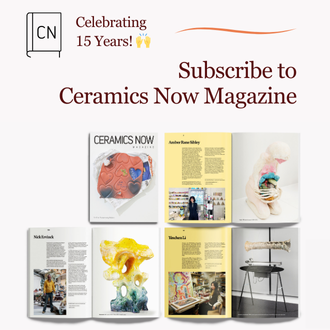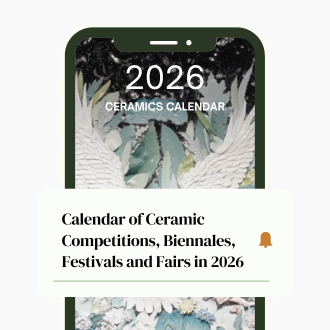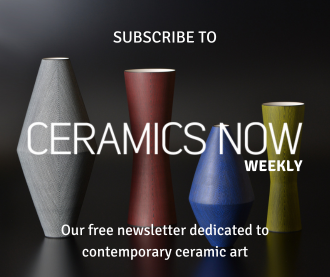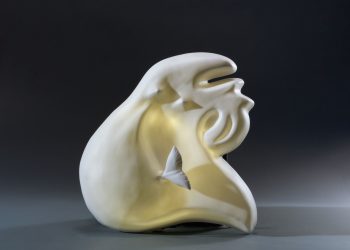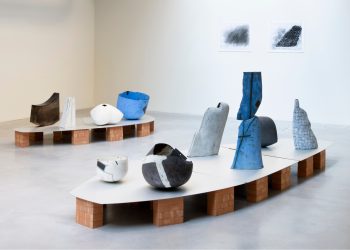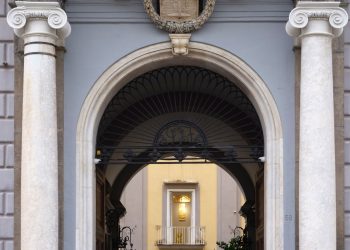
Ceramics Now Exhibition – International contemporary ceramics exhibition, 3rd edition
November 8-30, 2012
The international Ceramics Now Exhibition is an itinerary exhibition of contemporary ceramics which presents works of artists that are featured in Ceramics Now Magazine’s platforms or are invited. The exhibition reunites artists from different countries and communities, and facilitates contact between them and the public. Ceramics Now Magazine and Exhibition operate as an exchange platform between artists, galleries, museums, collectors and people passionate about art.
In the context of the globalization of arts and of rapid exchange of information, it is more and more necessary to make a serious coagulation of what is contemporary ceramics. The incorporation of many diverse subjects, working techniques and mediums in creating a ceramic object, are more and more frequent, risking if not counterbalanced, to take this domain back to crafts. The harmony between the compositional elements and concept can be realized through exercise, and this exercise is a reference point for contemporary artists. In creating a contemporary ceramic object, an equilibrium can be reached by those who feel the need to create and who create with depth. Originating either from Australia, Africa, Europe, Asia or America, practice, delicacy and accuracy are characteristics that unite them. The Ceramics Now Exhibition reunites these artists and brings their work together aiming to create an open platform between them and the public. The third edition of our main event will be held between 8-30th of November 2012, at Galateea Gallery, Bucharest, and will present the works of 22 world-renowned contemporary ceramic artists.
Download Press release and images / Facebook event
EXHIBITING ARTISTS: Steve Belz (USA), Gherghina Costea (Romania), Kimberly Cook (USA), Ossama Mahmoud Emam (Egypt), Nato Eristavi (Georgia), Jason Hackett (USA), Teresa and Helena Jané (Portugal), Brian Kakas (USA), Yoichiro Kamei (Japan), Kentaro Kawabata (Japan), Allison Luce (USA), Nicolae Moldovan (Romania), Akio Niisato (Japan), Heide Nonnenmacher (Germany), Szilvia Ortlieb (Austria), Barbara Schmid (Austria), Avital Sheffer (Australia), Suzanne Stumpf (USA), Kouzo Takeuchi (Japan), Shinya Tanoue (Japan), Kwok-Pong Bobby Tso (China), Gavril Zmicală (Romania).
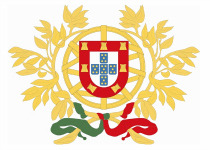
Curator: Vasi Hîrdo
Coordinator: Cristina Popescu Russu
Three Open lectures are organized in connection to the third Ceramics Now Exhibition. Read more about this.
Ceramics Now Magazine is a comprehensive and innovative publication & online art platform specialized in contemporary ceramics. Founded in 2011, the magazine celebrates the creative field of ceramics through publishing interviews, reviews and works of new and world-renowned ceramic artists, and providing information on contemporary ceramic art exhibitions.
Ceramics Now is a Non-profit Association. Our goal is to make contemporary ceramics a more visible art field and to support innovative and diverse ideas or techniques in the field. Consider making a donation to support our work.
Reopened at the initiative of the Romanian Fine Artists Union in December 2011, Galateea Gallery is the first gallery of contemporary ceramics in Romania. The gallery is located on 132 Victory Avenue, Bucharest, and is opened from Monday to Friday between 12 am – 8 pm (Mondays between 11 am – 7 pm). Victory Avenue is the main shopping street in the capital of Romania.
The third edition of Ceramics Now Exhibition is organized by Ceramics Now Association in partnership with the Romanian Fine Artists Union.
Exhibition promoted by The Embassy of Portugal in Romania
Media partners: Euronews, Radio România Cultural, Radio Guerrilla, DIGI24, ArtClue, Modernism, ArtAct Magazine, Observator Cultural, Senso TV, BeWhere, Metropotam, Vernisaje, STYLES, 24FUN, Şapte Seri, Zile şi Nopţi, Deco şi Eco, Neapărat, Slicker, Revista Căminul, Evenim, Alternativ, ArtLine, PORT, Agenţia de carte.
For inquiries please contact Vasi Hîrdo, Curator, at vasi@ceramicsnow.org
EXHIBITING ARTISTS:

— Steve Belz, Restrained, 2010, Low fired ceramic, Washes, Glazes, Wax, Rubber cords and copper wires, 20 x 17 x 10 cm.
STEVE BELZ (U.S.A.)Steve Belz is currently a Technician in ceramics and sculpture at The University of Montana, Missoula, MT, and he recently completed his MFA at The Kansas State University, Manhattan, KS. He has participated in over thirty international and national exhibitions in the past four years.
“My sculptures express the beauty of nature and the tension created by man’s manipulation of our environment. I use the beauty of form to increase the viewer’s emotional connection with nature. This connection to nature can expand one person’s, and ultimately our society’s compassion for the natural world.
Historically we have manipulated plants by gathering seeds, grafting limbs, and controlling pollination of plants with traits we find favorable. These qualities were gradually developed over countless generations. What is different about our more recent modification of plants is the far-reaching selection of traits from organisms that would not be accessible without genetic engineering.
I use manufactured elements in my work to create a tension meant to bring about a consciousness within the viewer, to open a dialogue about contemporary society’s association with nature. This discussion can raise awareness of the danger that our current situation poses. A lack of responsibility and stewardship for the Earth creates many problems for the planet, among them degradation of our basic life support systems, as reflected in the loss of biodiversity, increased toxicity of our food systems, inefficient use of natural resources and global climate change. I hope that my art will encourage viewers to educate themselves and become increasingly proactive in assuring a sustainable future.”
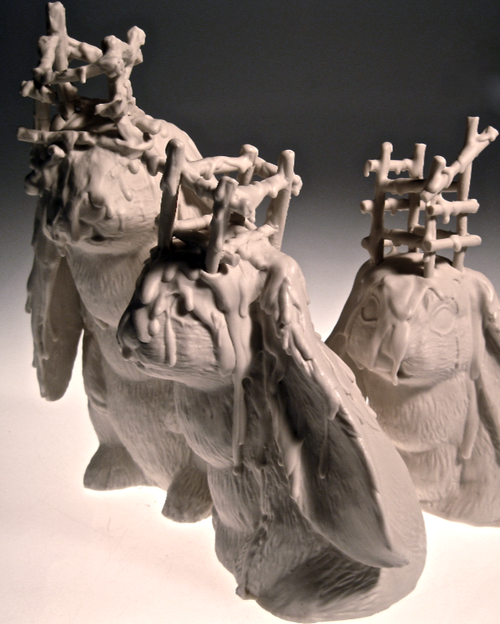
— Kimberly Cook, Last straw, That’s all, That’s it…, 2011, Porcelain, 30 x 15 x 10 cm. each.
KIMBERLY COOK (U.S.A.)
Kimberly Cook is currently an instructor in ceramics at West Valley College, Saratoga, CA. She has been working as an artist, using clay as the primary medium of expression, for ten years. She attended Texas A & M University, College Station, TX, where she studied Liberal Arts, and in 2008 she completed her MFA in Spatial Art at San Jose State University. She has participated in over thirty national and international exhibitions in the past four years.
“Awkward primitive animal instincts lie unconsciously in our genetic make-up. Dominance, survival, reproduction, and group instinct feed our propensity to digress into our egos; cruelty, alpha status, fight or flight, sexual exploits, and pack mentality. In my body of work I create imagery that embodies tension and anxiety, while also reflecting animalistic traits and certain elements of human ritualistic thought and control that intrigue me. Using clay as my primary sculptural material allows me to explore these thoughts and questions using techniques that actually originated in human ritualistic practices. Figures, deities, and fetishes were modeled into both animal and human form for magical or religious practices long before clay was used for utilitarian ware. This harnessing of imagery deemed as powerful has survived for centuries, allowing humans to access manifestations of supernatural forces believed to improve their daily struggles in life.
Personally and intuitively driven, my work with imagery of animals is grounded in the exploration of the universal human condition, focusing on aspects of the ceremonial; serving as embodiments for the physical, spiritual, and psychological being.My preoccupation with human existence, alienation, fear and apathy, is what motivates me to express elements of autobiography, ritual, and the significance of life’s struggles. Working between narrative and abstract, revealing both the perception of power and powerlessness, the figures and symbols that I create are often purposely rendered disfigured and dysfunctional.”

— Gherghina Costea, Regeneration, 2012, Body-stained stoneware, Hard porcelain, 90 x 53 x 32 cm.
GHERGHINA COSTEA (Romania)
Gherghina Costea was born in 1955 and graduated Ceramics at The Bucharest National University of Arts (Nicolae Grigorescu), in 1978. She is a full member of the Romanian Fine Arts Union, since 1990, and a member of the International Academy of Ceramics Geneva, since 2010.
“I have always been attracted by the language of all nature. Since childhood, having a life in strong connection with the nature, I remained with an organic perception of space and time. I feel how my soul vibrates the string of the same laws of nature.
In plants I saw the image of the Earth’s wisdom. Regeneration – this biological process which refers to the capacity of a portion of a plant and its power to grow back from the beginning. The original plant is a living example for us people to love the inner truth, to have the power to regenerate our spirit. The nature is the spring, the ferment and the mash.”
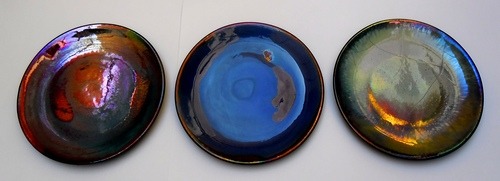
— Ossama Mahmoud Emam, Lusters, 2012, Ceramic, Glazes (copper, cobalt, silver nitrate), D27 cm. each.
OSSAMA MAHMOUD EMAM (Egypt)
Ossama Mahmoud Emam lives and works in Cairo, Egypt. In 1998 he graduated Ceramics at The Helwan University Cairo, and since then he had participated in over thirty international and national exhibitions. He has been awarded for his career with the Prize of The Egyptian State for Ceramic Art Creativity (Egyptian Academy of Arts, Rome 2004). His works are exhibited in public museums in Egypt, Greece, Italy, Dominican Republic, Turkey, Spain, China and South Korea.
“Architectural character is a key feature in the majority of my ceramic art. My work represents a dialogue between geometric constructions (boxes, circles, balls) and spontaneous expression, while searching for a new vision in the concept of ceramic form and its relationship with external emptiness.
The surface treatment does not rely on a particular technique, but is chosen to compliment the style of the form, to match and merge within the architectural entity of the form, creating one entity. There is an innate spontaneity in the touch of the maker’s hand – matching the shape of the form.”
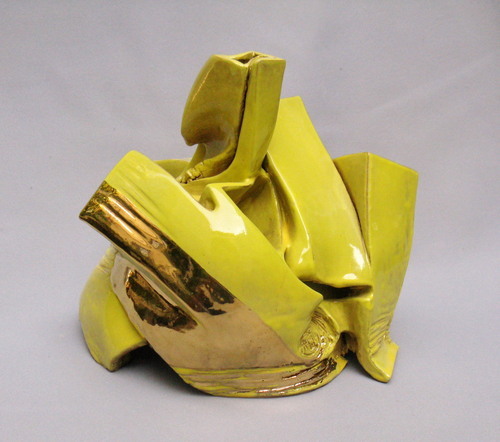
— Nato Eristavi, Collapse Art Series, 2012, Terracotta, Engobe, Oxides, Glaze, 30 x 25 x 30 cm.
NATO ERISTAVI (Georgia)
Nato Eristavi graduated Ceramics at The State Academy of Arts, Tbilisi, Georgia, in 1994. She has exhibited in numerous national and international exhibitions, and a few years ago she set up the first Georgian Ceramic art foundation, titled Clay Office. She is also the manager of Bao-Babi, the largest children’s entertainment centre in Georgia, and a teacher at The State Academy of Arts.
“A few years ago we set up a Georgian ceramic art foundation called Clay Office. I was very lucky to have such good friends. Clay Office brings together many Georgian ceramic artists. Five of us are the founders of the organization. My colleagues and I work together. The Academy of Art allocated space for us. We received a grant to fully equip the workshop with the necessary professional tools and we created favorable environment to work there.
I inherited this untiring optimism from my parents, and it’s a quality that works to my benefit. Self-control is necessary. Universal depression has consumed the world and it is easy to become immersed in this swamp. It is probably time for all of us to make each others life easier and encourage everyone around us. We should derive joy from simple things and be grateful for what we have. We should give each other warmth and be happy with what these relations bring to us. This is the greatest value that can be had.” (EGO Mag – Issue 1, Natuka Natsvlishvili, Tbilisi, 2012)

— Jason Hackett, Old Whimsy, 2012, Hand-made and found manufactured ceramics, 25 x 23 x 15 cm.
JASON HACKETT (U.S.A.)
Jason Hackett completed his MFA at The Virginia Commonwealth University, Richmond, VA, and holds a Bachelor of Science. He has exhibited his works in over thirty national exhibitions and currently works as a Technician in Ceramics at The Virginia Commonwealth University.
“I understand the world in an evocative fashion and view my artworks as both physical and philosophical memorials to ‘Closeness’. During the construction of new works in series, I commonly consider ideas such as the value of community and family, the honesty of both gross and tedious labor, and the mysteriousness of the metaphysical.
I primarily construct pieces using my hands and molding methods while also using found manufactured ceramics. Captured materials, images and forms; of man and of machine; from immediate and distant pasts are merged in commemorative context where contemplation defines their functional nature. Individually they are cups, plaques, and cultural icons made in clay. Collectively, they are symbols and metaphors simultaneously expressing proximity and distance, material and immaterial, and both the tangible and intangible.”
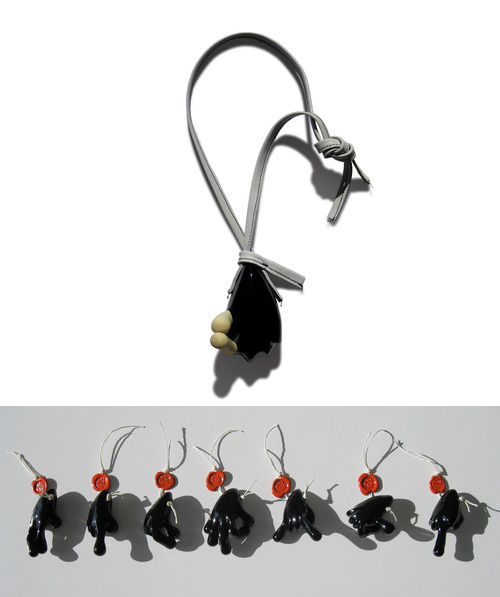
— Teresa & Helena Jané, FOD… Reborn, 2012, Black clay carved by hand, Glaze, Variable dimensions.
TERESA & HELENA JANÉ (Portugal)
Teresa & Helena Jané are two Portuguese artists that create author ceramic objects under the name of THJané. Their most recent project is a reaction to the political power abuse, but it shouldn’t be taken as an anti-Troika statement. Titled “FOD… reborn” as in the Portuguese saying “Vão-se os anéis, Ficam Os Dedos.” (“I may have lost the ring, yet the fingers are still there.”), the work speaks about the challenges of our modern societies but it also delivers optimism.
“Our dad was an architect, and mum was a teacher of arts and crafts. They invested strongly in our education for the discovery and exploration of unique artistic sensibilities, and we always felt responsible for giving them a well deserved response. We studied piano for several years and used to go to classical music concerts every weekend. We also had the opportunity to learn and practice woodwork and woodcut, ceramics and basketry, weaving and dressmaking, bookbinding, painting and engraving, and so many other useful things.
Years later, we set up THJané project and, until today, we still live with the feeling of achievement that comes with creating things of beauty with our own hands.” (Ceramics Now Magazine – Issue Two, Vasi Hîrdo, Cluj-Napoca, 2012)

— Brian Kakas, Architectonics: Hull Improv, 2012, White stoneware, Cone 04, Slab construction, 90 x 25 x 35 cm.
BRIAN KAKAS (U.S.A.)
Brian Kakas is an Assistant Professor of Ceramics at Northern Michigan University, Marquette, MI. He received his MFA in Ceramics from The University of Notre Dame, South Bend, IN, in 2007. During his masters he focused on large-scale mold making techniques for ceramic vessels through various research grants. Brian has taught and assisted workshops across the world and has been a resident artist in U.S.A., China and Indonesia.
“Appropriate means of creatively adapting to continual changes have been expressed though practices of art, architecture, science and technology. In this new body of ceramic works, entitled “Tectonic Perceptions”, the intentions are incorporating methodologies and theories from the mentioned practices to create a “new nature” in structural design for ceramic objects. The pieces seek to celebrate the versatility of clay with an aim of fostering new realizations of architectural space. Travels throughout Asia and an array of rich cultural experiences in China have brought about new realizations within the artist’s mind and perceptions of cultural identity, history and space. These relationships have allowed the artist to explore relationships between the strong elements of tradition and modern identities rapidly evolving around the world. Explorations of these interrelationships and the intentions of the maker and his material have led to the new structural ceramic designs.
Through his aspired process of invention, it is the artist’s intent to find a natural form by staying true to chosen materials and their inherent properties. The artist is in pursuit of finding and establishing a formal vocabulary that allows sculptural vessels to exhibit qualities of both unique and handcrafted objects of traditional cultures with that of machine made and mass-produced objects of our contemporary society. Synergism, formations of patterns and structures, of animals, plants and insects have strong influences over the creation of forms.”
“In our time the amount of change in environment to which an individual has to keep on readjusting himself psychologically is so great, and the pace of this change so rapid that the demand is straining the human’s capacity to adapt.” (Arnold Toynbee)
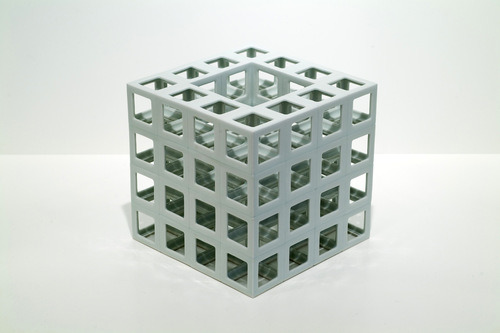
— Yoichiro Kamei, Lattice receptacle – A4, 2012, Porcelain, Slip casting, 18 x 18 x 18 cm.
YOICHIRO KAMEI (Japan)
Yoichiro Kamei was born in 1974 in the Kagawa Prefecture, Japan, and completed his Ph.D. studies in Ceramics at The Kyoto City University of Arts, in 2006. His works are exhibited in public collections at several international museums and institutions such as the The Bank of Kyoto, Yingge Ceramics Museum Taipei, Faenza International Museum of Ceramics or Icheon World Ceramic Center, in South Korea.
“Lattice Receptacle series is a work of art consisted of porcelain lattice structure as a fundamental form. Its creation is constructed by the accumulation of the base unit (cubic hollow) that is formed regularly using slip casting techniques.
For my expression in ceramics, the form and the internal space are the most important themes. The production method of unit accumulation derives geometric and formative aesthetics that also creates the capacity of space in density. The internal space that is opened by lattice structure becomes a device to receive lights, and together with permeability of porcelain it emphasizes the aspect of lights and shadows.
Every void plays a role as a receptacle, and they may find the meaning of existence by having themselves fulfilled somehow. It is the same principle underlies the void “on a plate” and the void “in space.” I believe that a further development in representing ceramic art holds a potential to satisfy people’s open senses, and invites us to the infinite experiences.“
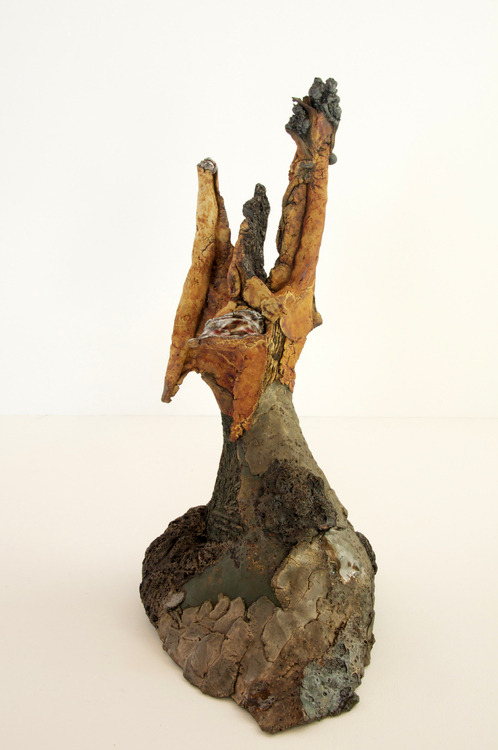
— Kentaro Kawabata, SOOS: Cao-Col, 2012, Porcelain, Silver, 25 x 18 x 40 cm.
KENTARO KAWABATA (Japan)
Kentaro Kawabata is a Japanese artist born in 1976. He graduated Ceramics at The Tokyo Design Institute in 1998, and since then he has exhibited in Japan, U.S.A. and South Korea. He is fascinated about the harmony of the different kinds of translucency between glass and white porcelain.
“Most of my pieces are made of porcelain clay with the coil technique. I prefer hand-building techniques to throwing, because it is easier for me to stay attuned to my feelings at the moment. Also hand building allows meto add different materials into the clay surface as I work, like bits of glass, stone, metal or sand.I am fascinated by the results of this fusion of different materials when the pieces have been fired.
SOOS is my latest series, and these pieces are made with porcelain clay that has been left over from previous projects or unfinished pieces. When I was looking at a field of grass through the windows in my studio, I realized how vigorous the weeds were. No matter how frequently they are cut, they start growing and blooming again, and the clipped weeds abandoned on the field become the organic fertilizer for the next season. I was impressed by the strength of the weeds and their cycle of life, and this inspired me to recycle materials and to use them for my new works. This influenced me to color my clay with a green pigment.
For me, just as the abandoned field sent out an S.O.S., my abandoned clay also sent out an S.O.S. because it needed attention. I began to see that all of my previous work and the left over clay, was the source of the energy of my future work. That is why I gave this piece the title of SOOS, because to Japanese people it sounds very similar to “SOURCE” when pronounced. I also think that my new series shows a different side of myself, which is a dark side.
The piece CAO-COL belongs to the Source series and represents a face which might show different aspects when seen from different angles or at different times. People sometime have hidden feelings which they can’t or won’t express facially; yet the truth may be hidden beneath the outer layers. I hope people might be able to imagine from the surface of my pieces what may be hidden from sight.“

— Takeuchi Kouzo, Modern Remains Y-II-11, 2011, Glazed porcelain, Slip casting, 42 x 40 x 40 cm.
TAKEUCHI KOUZO (Japan)
Takeuchi Kouzo was born in 1977 in Japan, and graduated Ceramics at The Osaka University of Arts in 2001. In the last ten years, Takeuchi has exhibited his works in over forty national and international exhibitions in Japan, U.S.A., France and Germany.
“I don’t know why, but I am attracted by square shapes. Though clusters of buildings or toy blocks were once my favorite things, I am now fascinated by what remains of old abandoned buildings. Because such deteriorated structures, which once stood majestically, appeal to me immensely, I have a feeling that I might be able to use this concept in my ceramic work. I want to express the emotion I feel when I look at the remains — mixed feelings about human achievement and the passing of time.
To express the power of creation by human being and the nostalgia of the distant past into my works, I have tried many things. As a result, I decided to break the pieces which were constructed of many hollow square tubes with a hammer after they were fired. Working in this way I began to realize that my work express not only the past, but also predict the future. Thus, I titled this series Modern Remains.”
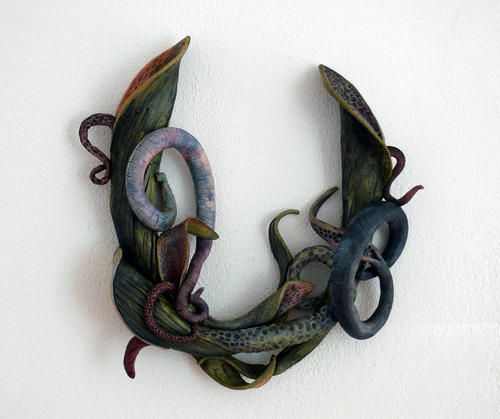
— Allison Luce, Enduring, 2011, Clay, Oxides, Mixed media, Cone 04, 35.5 x 34 x 9 cm.
ALLISON LUCE (U.S.A.)
Allison Luce explores the ephemeral nature of existence and the mystery of eternity through her ceramic sculptures and monoprints. Luce graduated with dual BFA degrees in Painting and Art History from Ohio University, Athens, OH and her MFA from Hunter College, City University of New York, NY. She currently lives and works in Charlotte, North Carolina where she is a studio artist and an adjunct art instructor. Over the past three years she has been a Resident Artist at the International Ceramic Research Center in Skaelskor, Denmark, the Zentrum für Keramik Berlin, Germany and Baltimore Clayworks, MD, U.S.A.
“Conceptually, this work is based upon the notion of the human body being a shelter for the soul. I work primarily in ceramics, connecting my artwork made in a post-modern context to the rich and ancient history of clay. Drawing inspiration from nature as well as art historical sources, I am attempting to rectify my current presence with a visual history from the past. I am particularly interested in iconography and the concept of a symbol or object conveying a meaning larger than itself. Beginning with the concept of clay as a metaphor for the body, these pieces are hand built and are hollow inside while mostly appearing to be solid. The hollow interiors of these pieces are symbolic of the soul, while the clay exterior references the delicate and ephemeral nature of life.
The Serpent Tree explores concerns about fragility and femininity and its relation to the concept of eternity. The idea for this body of work comes from the story of the Garden of Eden and explores issues regarding the frailty of the body and the fallibility of man. Referencing nature as well as the body, these sculptures are about growth, temptation and the passage from innocence to experience.”
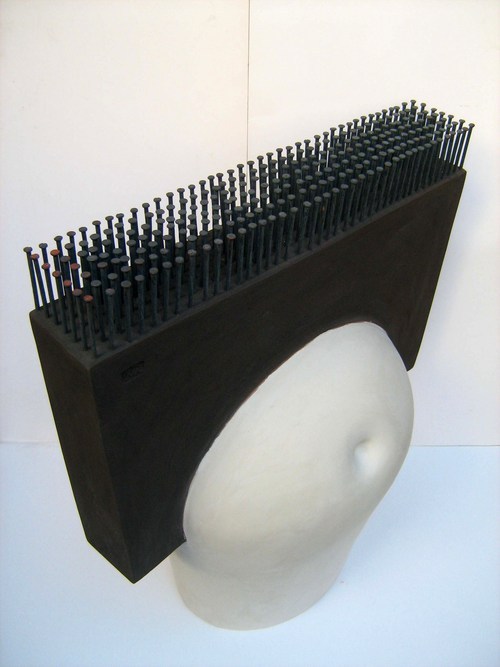
— Nicolae Moldovan, Personage, 2012, Handbuilt clay, Engobe, Metal, 70 x 61 x 35 cm.
NICOLAE MOLDOVAN (Romania)
Nicolae Moldovan graduated Ceramics at The Bucharest National University of Arts in 1998, being one of Alexie Lazăr Florian and Doru Marian’s pupils. In the last twenty years, he has participated in solo and group exhibitions in Romania, Germany, South Korea and Bulgaria.
“My work lives through their clean shapes and through the essentialized force given by the form. From time to time, the original form interacts with elements from other materialities, starting a conflict and aggressing the original.”
“Interested in the Cucuteni Culture, the last prehistoric culture with painted ceramics in Europe, Nicolae Moldovan studied and decided to create vases and antropomorphic forms respecting the neolitic technique of manual molding, using only natural mineral engobes. The geometric images are reminding us of neolitic ceramics through the color palette.
The archetypal and minimal forms of his works prove to be receptacles of a metaphorical universe in which the purity and cruelty, the smile and cynicism seem to complement each other.
The world proposed by Nicolae Moldovan is one of continuances, dressed in the fragile clothing of ceramics.” (Cotidianul, “From Cucuteni Culture to minimalism”, Victoria Anghelescu, Bucharest 2012)
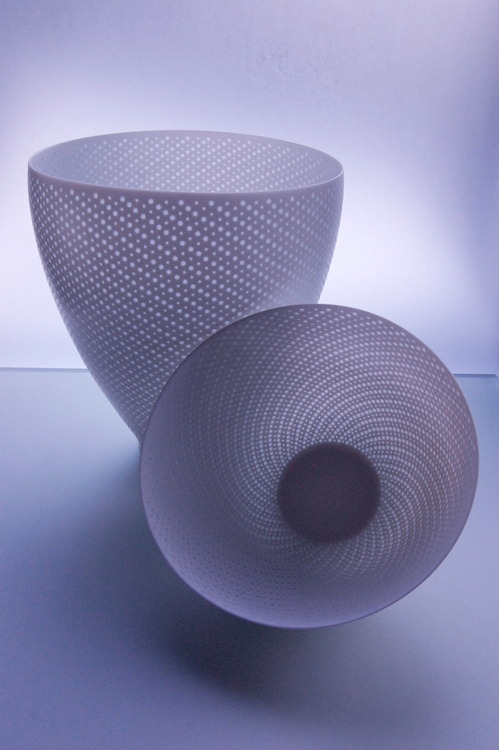
— Akio Niisato, Luminescent Vessels, 2012, Glazed porcelain, Multiple firings, 21.5 x 22.5 and 19.5 D x 11 H cm.
AKIO NIISATO (Japan)
Akio Niisato is a Japanese artist born in 1977 who graduated Ceramics at The Tajimi City Ceramic and Design Center, in 2001. He has been awarded with the 54th Premio Faenza International Competition of Contemporary Ceramic Art in 2005, and more recently he was Artist in Residence at Harvard Ceramic Program, Boston, MA, U.S.A.
“My current body of work is my series Luminescent Vessels. This series attempts to go beyond the practical limitation of vessels and explore the forms as objects of beauty and expression of ideas.
Early in my career I was influenced by the celadon wares of China’s Song Dynasty, and also by contemporary Japanese ceramists of 1980s and 90s. The ceramics of the Song Dynasty aspired to purity and perfection of form, but were generally valued more as status symbols than as functional items. The Japanese ceramics of the 80s and 90s, on the other hand, seemed to express beauty or other aesthetic concepts with little or no concern for conventional functional forms. In uniting these two approaches to the form, I feel I am able to harness the expressive possibilities of pottery.
My work is an attempt to release pottery from the curse of functionality. Opening holes in vessels that correspond to my concept of perfect form, I release them from their practical roles as functional vessels; when these holes are filled by clear glaze, the work once again fulfills the form of a vessel. Light passing through the glaze creates the luminescence for which this series is named.
The Luminescent Series may appear to be focused solely on simple beauty, but this simplicity is offset and complicated by the holes piercing the vessel’s form. This leads to a broader consciousness of form and thus a heightened appreciation of the forms of vessels that otherwise might be overlooked because of their everyday familiarity.”

— Heide Nonnenmacher, Orto botanico, 2011, Paperclay porcelain, 20 x 12 x 12 and 10 x 8 x 8 cm.
HEIDE NONNENMACHER (Germany)
Heide Nonnenmacher is a German ceramic artist born in 1951 in Stuttgart. She has exhibited her works in over forty exhibitions over the past decade and since 2005 she is a member of the International Contemporary Ceramic Art Vienna. Her studio, placed in the in the historical town of Nattheim, recently celebrated 30 years of activity.
“When I have an idea, I must infiltrate into the roots of it until it is satisfactorily resolved. At the same time I need to see changes in order to be fascinated.” Heide confesses. Positive restlessness and curiosity, openness to everything that occurs in nature, spontaneity and experimentation are her drives.
With numerous national and international exhibitions, many symposia and workshops helf in Japan, Austria, Russia, France, Turkey or China, Heide Nonnenmacher uses paperclay as the main material in her work: “porcelain brings together both the light and the earth qualities in itself.”
For her latest work, nature is modeled with its varied organic shapes to create insect nests. She formed hundreds of very thin rolls, similar to Calyx flowers, and put them together. She exhibited the resulting nests (titled Orto botanico) in August, at Ceramica Multiplex 2012 in Varazdin, Croatia.
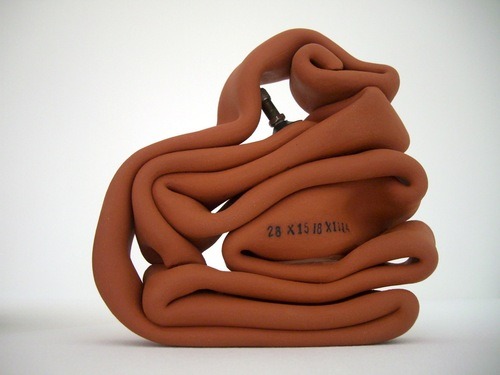
— Szilvia Ortlieb, Tire 28×15/8 x 11/4, 2011, Terra Cotta, Valve, Cardboard box, 20 x 20 x 6 cm.
SZILVIA ORTLIEB (Austria)
Szilvia Ortlieb was born in Hungary and since 1990 lives and works in Austria. She first encountered ceramics in Kecskemét, home of the International Ceramics Studio. In the last ten years she had exhibited her works in numerous international exhibitions.
“Ortlieb’s pronounced interest in collecting is evidenced by her rubber objects, and her sculptures made of abandoned light tubes, telecommunication cables, cable binders and bathroom scales. She finds objects, often discarded industrial waste, such as the ropes of LED lights in the 2008 sculpture in.halt, or uses found objects bought deliberately in a store (found only in the sense that, for example, in Waagrecht für senkrecht – Horizontal for Vertical, 2012, an installation of digital bathroom scales, the bathroom scales were spotted in a newspaper flyer advertisement).
Szilvia Ortlieb evinces a strong curiosity about the world around her. Her eye is ever watchful for outsiderness, even to the point of actively incorporating material into her work that is not perceived as valuable by society in general. She is like a researcher in her approach to her themes and materials. Pushing whatever ideas she has in her head and elements she has in her hands to their limits is fundamental for her. Therefore, she works in series, often titling the works in the series with the same name, exploring every aspect of the series until satisfied that she has exhausted its possibilities, and can move on.
Objects to please and sensitize the touch: to define space: to play with light and shadow in strong and basic colors – primarily but not exclusively shades of red, black, white and grey – are the product of Szilvia Ortlieb’s hands.” (Dr. Renée Gadsden, 2012)
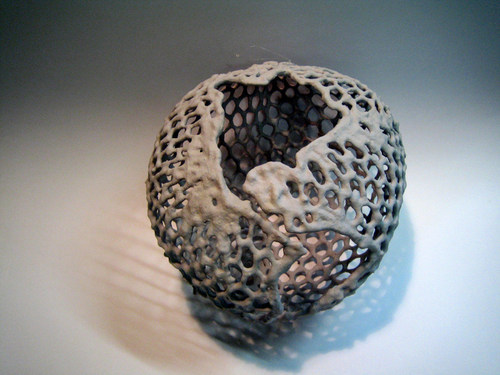
— Barbara Schmid, Fragile, 2010, Paperclay, D 35 cm.
BARBARA SCHMID (Austria)
Barbara Schmid is an Austrian artist who graduated Ceramics at The University of Graz, in 1988 (BA) and 2007 (MA). She was awarded the Prize of the City of Varazdin, Croatia, in 2009, and since then she had exhibited her works nationally and internationally.
Barbara Schmid transposes her work in connection to contemporary experimental aesthetics. Her ceramic objects reveal fluid and spherical forms. Through a long-lasting process of intermissions, the fluid components combine with the previous metal structures. The burning process reverses the procedure, the sustaining structure becomes fluid and the fluid structure becomes solid. Movement in fluid and solid is being captured in form as a defining moment.
“This work consists in hanged fragile ceramic objects which look like as frozen gestures. For the production of objects, we need hands as well as to communicate with them. A handmade object should be valued and understood.”
(Translation by Andreea Breaz)
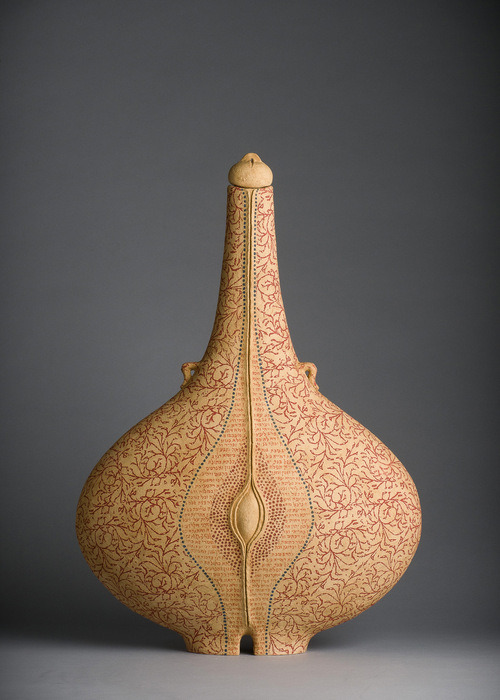
— Avital Sheffer, Seed I, 2011, Hand-formed clay, Glaze, Print, 65 x 45 x 27 cm.
AVITAL SHEFFER (Australia)
Avital Sheffer is a ceramic artist based on the North-Coast of NSW, Australia. She creates generous ceramic vessel forms, strong in presence and refined in detail. From her native country of Israel she brings a deep engagement with multi-faceted Middle–Eastern cultures, history and design – complexities and dilemmas she explores in her work. Since 2004 Avital had been exhibiting extensively in Australia and the US. She was a finalist in numerous competitions and won several awards including the Josephine Ulrich prize for excellence at the Gold Coast international Ceramic Award in 2005 and The Border Art Prize in 2008. She is a member of the International Academy of Ceramics.
“I am intrigued by our intimate relationship to the crafted object. The embodiment of utility, divinity and beauty in the vessel form is as ancient as the existence of human consciousness. The process of making my ceramic vessels is animated by ideas of fecundity and containment intrinsic to the human form and the natural world. These notions find resonance in mythology, language and the hand-made object throughout history. My vessels speak of a conversation between ancestry and the present.
Clay – with its malleability and transformations, fragility and endurance – is both an elemental medium and a record-keeper of lived experience and culture. Its mysterious and sensual nature and the fact that it is literally grounded suggest a metaphor for human life.”
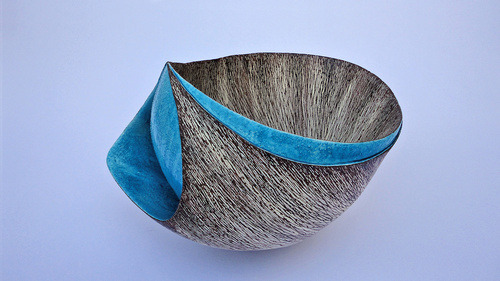
— Tanoue Shinya, KARA’11 – FU-f (Shell’11 – Eclosion-f), 2011, Hand-built clay, Sgraffito, 31 x 39 x 25 cm.
TANOUE SHINYA (Japan)
Tanoue Shinya is a Japanese artist who lives and works in Kyoto, Japan. He graduated Arts at The Kyoto Saga University of Arts in 2003, and since then he exhibited his works in over 40 national and international exhibitions across the world. In 2005 he received the Jury’s Special Award of the MINO International Ceramics Exhibition.
“Shells are an integral part of my life. The very thought of new life emerging from a shell excites me. It reminds me of the beginning of life on Earth – a subject that continues to fascinate me. If those who see my work get a sense of this, then I am very happy.
Just as a shell is made by the division of cells over time, my work is also developed by a complex process over time. My ceramic pieces are hand built. After the application of white slip before firing, surface patterns are scraped with a needle. After the first firing, the surfaces are sanded and small pieces of iron are inlaid into the scratched grooves. Then a clear glaze is applied and the pieces are fired the second time. Finally, a copper glaze is partially applied and the pieces are fired the third time. While working through this complicated procedure, I am anticipating that something new will be born.”
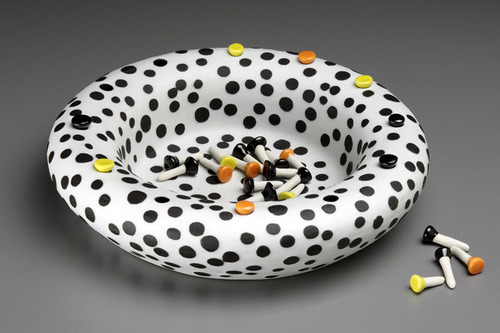
— Suzanne Stumpf, Interactive Sculpture No. 8, 2009, Porcelain, Reduction fire to cone 10, 20 x 20 x 5 cm.
SUZANNE STUMPF (U.S.A.)
Suzanne Stumpf has received national and international recognition for both her sculpture and functional ceramic creations. Her work is included in the 2009 Lark Books, 500 Ceramic Sculptures: Contemporary Practice, Singular Works, and in the 2011 book, 500 Raku: Bold Explorations of a Dynamic Ceramics Technique. In 2008 she was awarded an Artist Fellowship from the Somerville Arts Council, MA.
“Art should move the viewer away from a type of isolation that has been brought on by the abundance of “personal” technology that has come about during our time. In the evolution of my work, the questions that have guided me (at times, subconsciously) have been “what can inspire connectedness?” and “what can most powerfully engage our attention?” Thus much of my work is meditative for the audience, either in the questions it poses or the interaction/exploration it invites.
Increasingly my work has been sculptural, with a focus on making multi-component, interactive sculptures. Most of these works have innumerable permutations for viewing. Perhaps partially influenced from my background as a professional musician, these flexible sculptures allow for creating variations in the artwork such as might be experienced in the live performance of a musical composition from concert to concert. Some of the works may appear to be “games,” but generally there are no rules for arranging the components.
I work primarily in porcelain because this clay body receives and juxtaposes textures so articulately. Glazes are employed minimally; some works only make use of slips, underglazes, and oxide washes. My building combines altered wheel-thrown as well pure handbuilding techniques.“

— Kwok-Pong Bobby Tso, Industrial landscape: The View From Above I, 2011, Earthenware, Plastic, Metal, Wood, 45.7 x 38 x 20 cm.
KWOK-PONG BOBBY TSO (China)
Kwok-Pong Bobby Tso is a Chinese (Hong Kong) artist who lives and works in Iowa, U.S.A. He is currently studying towards a Masters of Fine Arts (Dimensional Practice in Ceramics) at The University of Iowa, Iowa City, IA. Over the past ten years he has participated in numerous international exhibitions, residencies, artist talks, and has been awarded full scholarships. He received The Rodger Lang Award for Student Excellence at NCECA 2011.
“The concept of my recent work is form and grows from my curiosity about the relationship between one object to another. In my work I aim to explore the joyful, interesting, and mysterious relationship between how one object fits unexpectedly into the other and becomes a whole new composition that has simple components but a complex configuration.
It is my intention that by using my work, I am able to trigger the viewer to look closer and rediscover the ordinary, yet unfamiliar relationships that are within all objects as well as all human beings. Through sensation, communication, investigation and exploration, both objects and humans are able to obtain appropriate space and attention. I hope my work can provide this perception of the relationship, but more importantly is to enrich this relationship and establish a sense of place as well as the idea that we are all part of something, something bigger.”

— Gavril Zmicală, Couple, 2012, Stoneware, Glaze, 40 x 28 x 10/20 cm.
GAVRIL ZMICALĂ (Romania)
Gavril Zmicală graduated Ceramics at The Ion Andreescu Institute of Fine Arts Cluj-Napoca, and in the past twenty years he has exhibited his works in numerous national and international exhibitions in Japan, Austria and The Netherlands. He is currently studying towards a Masters in Applied Biotechnogies.
“Between the skin of the clay and the intelligence of shape there is a secret interval, a dangerous opening in the field of art, which I often span with my artworks, each of the latter ones marking key points of crisis of this journey. They conjure up essential questions I confront within shapes: What happens at the boundary between the human being and the world? Between the soul being and the world nature? Between shape and its significance? How can the two worlds communicate, inner and outer? What must and what should a human being accomplish, body and soul, in order to break the time and space limits, to achieve beyond the multitude of gates and doors which trouble the path to himself? And more than this, how can the plastic art coherently articulate all these question marks?”
Previous exhibitions organized by Ceramics Now Association:
• Ceramics Now Team Exhibition, First edition / Europe Gallery, Braşov, Romania / September 1-14, 2012
— EXHIBITING ARTISTS: Andra Baban, Vasi Hîrdo, Alexandra Mureşan, Cora Pojaru, Anca Sânpetrean, Bogdan Teodorescu.
— Curator: Vasi Hîrdo
• Ceramics Now Exhibition, 2nd edition / Galateea Gallery, Bucharest, Romania /April 19 – May 7, 2012
— EXHIBITING ARTISTS: Arina Ailincăi (RO), Chang Hyun Bang (KR), Antonella Cimatti (IT), Patrick Colhoun (UK), Romana Cucu Mateiaş (RO), Carole Epp (CA), Simcha Even-Chen (IL), Shamai Gibsh (IL), Mark Goudy (US), Roxanne Jackson (US), Marta Jakobovits (RO), Margrieta Jeltema (IT), Maciej Kasperski (PL), Jim Kraft (US), Cynthia Lahti (US), Claire Muckian (IE), Connie Norman (US), Aniela Ovadiuc (RO), Oriana Pelladi (RO), Eugenia Pop (RO), Cristina Popescu Russu (RO), Liza Riddle (US).
— Curator: Romana Cucu Mateiaş
— Coordinator: Vasi Hîrdo
• Ceramics Now Exhibition, First edition / The Paintbrush Factory (Fabrica de Pensule), Cluj-Napoca, Romania / December 9, 2011 – January 6, 2012
— EXHIBITING ARTISTS: Chang Hyun Bang (KR), Antonella Cimatti (IT), Patrick Colhoun (UK), Carole Epp (CA), Simcha Even-Chen (IL), Shamai Gibsh (IL), Mark Goudy (US), Roxanne Jackson (US), Margrieta Jeltema (IT), Maciej Kasperski (PL), Jim Kraft (US), Cynthia Lahti (US), Claire Muckian (IE), Connie Norman (US), Liza Riddle (US).
— Curator: Vasi Hîrdo
▬▬▬▬▬▬▬▬▬▬▬▬▬▬▬
CERAMICS NOW MAGAZINE | SHOP
Subscribe to Ceramics Now or consider making a donation to support our work. All proceeds made will go back into Ceramics Now Magazine.
Read more about us.
CONTACT
office@ceramicsnow.org
Tel. +4 0748 311 663
Subscribe to our free monthly newsletter and follow us on Facebook, Pinterest, Twitterand LinkedIn.


